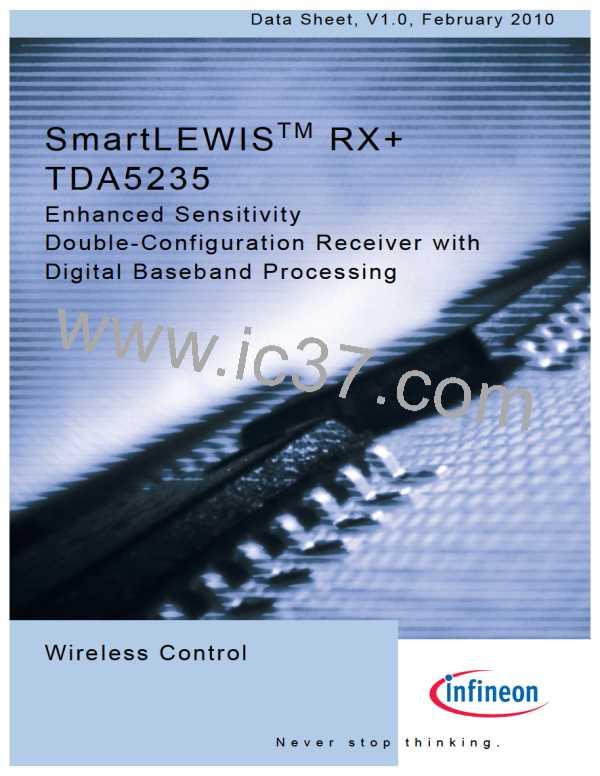TDA5235
Functional Description
SSync Search Time Elapsed =1
SSync=0
Reset
Init Wakeup Unit
Idle
WU=0
No WU=0
SSync=1
Wakeup Criteria=Pattern Detection
SSync=1
SSync=1
SSync=1
Wakeup Criteria=Valid Data Rate
Detection
Wakeup Criteria=Random Bits Detection
Wakeup Criteria=Equal Bits Detection
WUW Chip Counter<
WUBCNT
WUW Chip Counter<
WUBCNT
Equal Bits
Detection
SSync=0
Pattern Detection
Random Bits Detection
SSync=0
CV=1
WUW Chip
Counter<WUBCNT
WU=0
No WU=0
WU=0
No WU=0
WU=0
No WU=0
Bit Change Detected=1
SSync=0
CV=1
WUW Chip Counter elapsed
(WUW Chip Counter=
WUBCNT)
WUW Chip Counter elapsed
(WUW Chip Counter = WUBCNT)
WUW Chip Counter elapsed
(WUW Chip Counter= WUBCNT)
Pattern Match=1
Wake-Up
WU=1
No WU=0
No Wake-Up
WU=0
No WU=1
Figure 25
Wake-Up Data Criteria Search
2.4.8.6 Frame Synchronization
The Frame Synchronization Unit (Framer) synchronizes to a specific pattern to identify
the exact start of a payload data frame within the data stream. This pattern is called
Telegram Start Identifier (TSI).
There are different TSI modes selectable via the configuration:
• 16-Bit TSI Mode, supporting a TSI length of up to 16 bits or 32 chips
• 8-Bit Parallel TSI Mode, supporting two independent TSI pattern of up to 8 bits length
each. Different payload length is possible for these two TSI pattern.
• 8-Bit Extended TSI Mode, identical to 8-Bit Parallel TSI Mode, but identifies which
pattern matches by adding a single bit at the beginning of the data frame
• 8-Bit TSI Gap Mode, supporting two independent TSI pattern separated by a
discontinuity
All SFRs configuring the Frame Synchronization Unit support the Multi-Configuration
capability (Config A and B). The Framer starts working in Run Mode Slave after Symbol
Sync found and in Self Polling Mode after wake-up found and searches for a frame until
TSI is found or synchronization is lost. The input of the Framer is a sequence of Bi-phase
Data Sheet
55
V1.0, 2010-02-19

 INFINEON [ Infineon ]
INFINEON [ Infineon ]